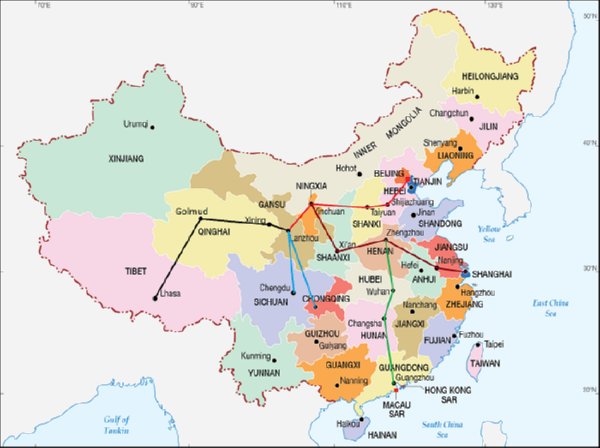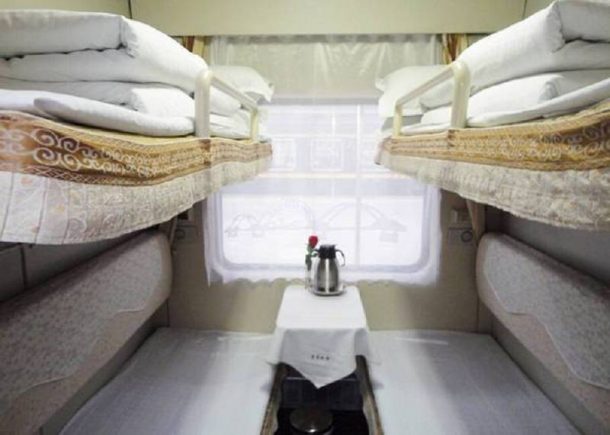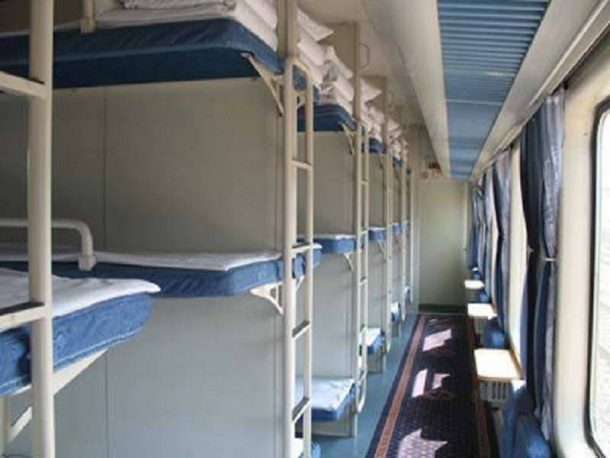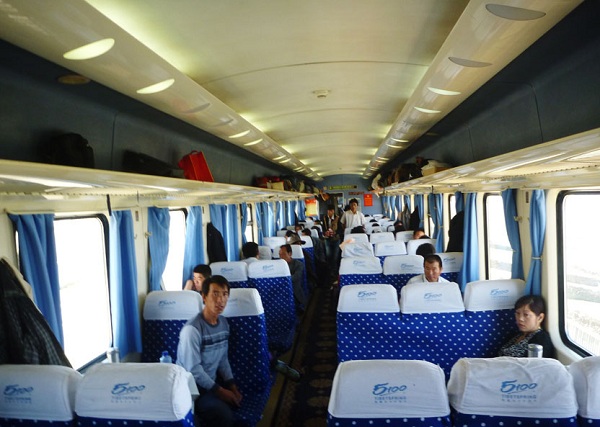Taking trains to Tibet the Roof of the World
While taking a flight to the Tibetan capital of Lhasa may be the fastest option. But it is not always the most cost-effective and can be an expensive trip for such a short flight. However, there is an option that is taking trains to Tibet, can be a lot less costly and has the advantage of giving you a small tour of a part of Tibet you are unlikely to see on an organized tour.

Since it first opened in 2006, the Qinghai Tibet Railway has been the most beneficial route to Tibet for foreign and domestic tourists alike. And while it can take as long as three days to get there, depending on your departure city. It is well worth the time to enjoy such a relaxing ride on a train. The routes take you across parts of mainland China and traverse a huge tract of the Tibetan plateau north to south.

And it is not just the reduced cost and relaxing travel that makes the train the ideal option for travel to Tibet. There is a myriad of reasons why to take the train, although the common “myth” of helping with acclimatization is not one of them. Trains may take longer but they all travel the same route from Xining to Lhasa. By cross some of the most stunning landscapes in the world. And you will get to pass through and see a part of the Nagqu Prefecture, most of which is made up of plains and grasslands where few people live.

This untouched wilderness is home to several species of indigenous animals. Including the wild donkeys, yaks, Tibetan antelopes, and the cute little pika. If you are lucky enough to catch a glimpse of one from the train. You also get to see some of the amazing worlds records that this spectacular railway has broken, including the Highest Railway Pass in the world, the world’s longest plateau tunnel, and the world’s highest railway tunnel, to name a few.
Table of Contents
Train departure locations

The trains to Tibet depart from seven gateway cities across mainland China, although you can actually catch the train from eight different cities. This gives you the opportunity to be able to catch a train from a nearby city, no matter where you land in China after your international flight.
Guangzhou
Trains leave daily from Guangzhou in Guangdong Province of southern China. The longest of all the routes to Tibet, the Guangzhou-Lhasa train takes around 55 hours to cross China to Lhasa and arrives in the Tibetan capital in the afternoon of your third day.
Shanghai
The route from Shanghai to Lhasa is a journey of around 4,373 kilometers and is the second longest route to Lhasa. Trains depart for the Tibetan capital on a daily basis, and take around 47 hours, reaching Lhasa in the afternoon of the third day.
Beijing
Beijing is one of the first routes that ran to Lhasa along the Qinghai Tibet Railway, and it takes around 40 hours to reach Lhasa from China’s stunning capital city. Trains depart every day, and the journey covers a distance of 3,757 kilometers over three separate days.
Chengdu
With a total travel time of 37 hours, the trains from Chengdu leave in the late evening and arrive in Lhasa in the morning of the third day. Covering a distance of 3,070 kilometers, the train from Chengdu is one of the most popular routes of them all. However, trains only leave every other day, with departures on odd or even dates, depending on the month.
Chongqing
Trains from Chongqing leave for Lhasa every other day, on either odd or even dates in the month. The train takes around 35 hours to reach the Tibetan capital, covering a distance of 3,030 kilometers. The trains from Chongqing are the shortest trips that cover three separate days, with the trains arriving in the early morning of the third day.
Lanzhou
Lanzhou, in the Gansu Province of northwest China, is the second shortest journey to Lhasa by train. It takes only 24 hours to reach Lhasa. At a distance of just 2,188 kilometers, the every-other-day trains arrive in Lhasa at around 9:30 am on the second day of travel.
Xining
The shortest route to Lhasa and the start of the official Qinghai Tibet Railway, trains leave from Xining Station every other day and arrive in Lhasa in the morning of the second day. Xining is not only the most popular departure city in China. It is also the train with the largest number of seats of sleeper berths. The train is longer from Xining than from any other gateway city, which makes getting the tickets easier than anywhere else in the peak season. All trains passing through Xining to get onto the Qinghai Tibet Railway to Lhasa. The trip covers around 1,972 kilometers and takes around 22 hours.
Xi’an
While trains do not depart from Xi’an, the capital of Shaanxi Province in Northwestern China. But the trains from Guangzhou and Shanghai both pass through the city, allowing passengers to embark there if there are spaces and tickets available. However, this is not an advisable departure location in the peak months. As tickets from Xi’an are almost impossible to obtain due to trains being full from their original departure cities.
Trains to Tibet: Ticket Types
Trains to Tibet have three classes of tickets; Soft Sleeper, Hard Sleeper, and Hard Seat. Soft Sleeper berths are the costliest, while the more uncomfortable Hard Seats (which are not actually hard!) are the cheapest option. Hard Seats are not usually recommended for these long journeys, as they can get uncomfortable, and it is a long ride to Lhasa from anywhere in China.

Soft Sleeper cabins are the first-class option, and consist of four bunks over two levels, in a private cabin with a lockable door. Cabins are often shared with other passengers. If you are a woman traveling alone, the staff at the station and on the train can usually arrange for you to be berthed with other women only.

The Hard Sleeper berths are less private, being open to the train’s corridor and having only a small curtain for a modicum of privacy. Berths are on three levels with six bunks in each compartment. The beds are not hard, though, and are a comfortable cheaper option than the Soft Sleeper.
In both types of cabins, it is normal for all the passengers to sit on the lower bunks during the day. So it is advisable to ask for an upper or middle bunk if you plan on doing any resting or sleeping during the daytime on the train. This is a common and widely accepted practice across China, but it can be fun to chat with the others while you travel.

The third-class option, the Hard Seats, are not really recommended for long-distance travel and are normally used by those locals with a very limited budget for travel. Many Tibetan traveling back to the plateau will use the Hard Seats, as it is much less costly for them. However, if you think you can manage to last for 22-24 hours in the same seat. Then the trains from Xining and Lanzhou would become the very cheap option to save money.
Cost of Tickets
The actual price of the tickets to Tibet depends on which city you are leaving from and the time of year that you are traveling. In the peak season for Tibet tourism, ticket prices usually increase as demand increases and can cost more than the prices we have shown here. However, this is still a lot less expensive than flying, so is still cost-effective.
Ticket Price (in Chinese Yuan)
Guangzhou to Lhasa
Hard Sleeper: 865 CNY, Soft Sleeper: 1468 CNY
Shanghai to Lhasa
Hard Sleeper: 794 CNY, Soft Sleeper: 1262 CNY
Beijing to Lhasa
Hard Sleeper: 720 CNY, Soft Sleeper: 1144 CNY
Chengdu to Lhasa
Hard Sleeper: 628 CNY, Soft Sleeper: 998 CNY
Chongqing to Lhasa
Hard Sleeper: 628 CNY, Soft Sleeper: 998 CNY
Lanzhou to Lhasa
Hard Sleeper: 522 CNY, Soft Sleeper: 823 CNY
Xining to Lhasa
Hard Sleeper: 495 CNY, Soft Sleeper: 781 CNY
Xi’an to Lhasa
Hard Sleeper: 611 CNY, Soft Sleeper: 969 CNY
Recent Posts
The Perfect Tibet Tour Package
Journey to Tibet
Exploring Tibet
All Categories
- About Tibet
- book a Tibet tour
- Buddhism Practice
- Budget Tour
- China-Tibet Train
- Customized Tibet tour
- Historical Sites
- Hot Springs in Tibet
- News
- Photography in Tibet
- Tibet attraction
- Tibet Group Visa
- Tibet Motorcycle Tour
- Tibet Small Group Tours
- Tibet Tours and Tibetan Tour Guide
- Tibet Train
- Tibet Travel FAQs
- Tibet Travel Information
- Tibet Travel News
- Tibet Travel Permit Update
- Tibet Travel Prices Rises
- Tibet Trek
- Tibet Trekking Tour
- Tibet weather and climate
- Tibet Wildlife animals
- Tibet Winter Tour
- Tibetan Buddhism
- Tibetan Cultural Features
- Tibetan Culture and Poeple
- Tibetan Festivals
- What to see in Tibet



